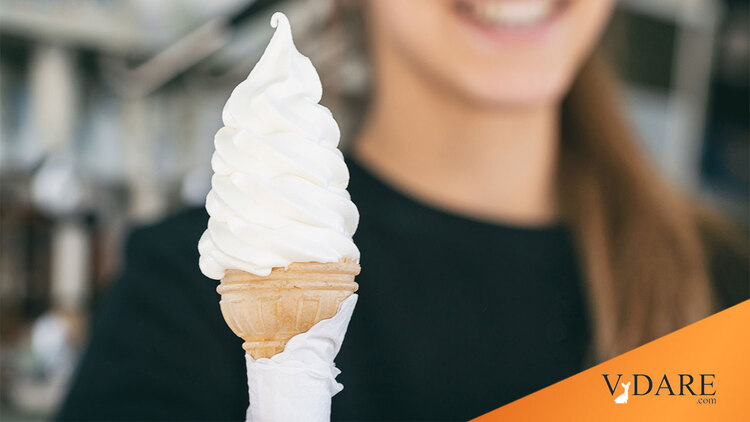How Did Vanilla Become a Byword for Blandness?
The spice is one of the world’s most elusive, complex and hard to cultivate ingredients. But for many Americans, it still represents a “boring” choice.
By Ligaya Mishan
Sept. 8, 2023
IF, PRESENTED WITH all the ice cream flavors in the world, you ask for vanilla, you are making a declaration: “Not for me a life of adventure. I choose the road more taken.” This is the default, the dead end, where imagination is extinguished. In idiomatic usage, per the dictionary, “vanilla” (or, more damningly, “plain vanilla,” as if that were not redundant) means “having no special or extra features.” So: the bare minimum, the absence of flourish, the annihilation of fun—buttoned-up and bougie, innocuousness incarnate. In a word, a bore.
How then am I woozy and heavy-lidded in the presence of a single vanilla bean? It lies on my desk, skinny as a twig, with a little curling hook at one end, like a fossilized crochet needle, rough yet pliant to the touch. I am trying to write but the room is possessed by that scent, a summons of honeysuckle, sun-fat figs and red wine, of the dank sweetness of soil when the rain has soaked through it.
What is this disconnect between the genial vanilla of the mind and its heady, almost unruly scent and flavor? Depending on where the beans are harvested, vanilla may taste dark-sweet, of smoke and cherries; or earthy as chocolate and coffee; or buttery, or caramelly or plummy; or stung by the faintest numbing hint of anise. But almost none of the vanilla in global circulation comes from beans at all. More than 99 percent of the world’s vanillin—the chemical compound in vanilla that is predominantly responsible for its aroma and flavor — is artificially synthesized,
So inseparable is vanilla from its manifestation in ice cream that, for Americans, it comes perilously close to a synonym for “white,” even though the beans and seeds are black. Earlier this year, a so-called vanilla girl aesthetic had a moment on TikTok as an embrace of neutral tones and minimalist makeup, along with cozy atmospherics (candles, fluffy duvets), then earned a backlash from those who saw it as exclusionary, valorizing the lifestyles of skinny white girls (which of course makes it not so different from most viral TikTok aesthetics). …
Or have we misunderstood vanilla all along? Many of us are so accustomed to the taste of artificial vanillin that we can only vaguely recall the dark cured beans. Instead we conjure images of pallor (angel food cake! yogurt! meringue!) and a vibe. And maybe this is vanilla’s trick, to elude us. As an ingredient, it can be deceptively reticent, seeming to cede the spotlight to the more forceful pleasures of sugar and cream. Yet it transfigures every flavor it encounters. It calms and contours, steadies and exalts. It is the spice with the Midas touch that makes more more.
I finally started to understand when my wife mentioned that sometime before WWII her grandfather had worked inside a Chicago ice-cream factory. He came home and told his children, “After what I saw today, never eat any flavor of ice cream other than vanilla.” …
But Bobrow-Strain’s article includes a key statistic. In 1890,
…bread was the country’s single most important food and 90 per cent of it was baked in homes by women. By [1930], bread was still the country’s number one food, but 94 per cent of it was baked outside the home by men.
… One solution favored by some immigrant groups was to rely upon a trusted neighborhood delicatessen with famously high standards. The ethnic deli method was especially popular with cultures that traditionally endorsed complicated food taboos that made it difficult to share a convivial meal with outsiders. Of course, it also tended to exacerbate immigrant ethnocentrism, making them nervous when they dined away from their home turf, as when Alvy Singer tries to eat an Easter ham with Annie Hall’s family.
In contrast, the Pure Foods Movement that WASP ladies (many of whom were also in the temperance struggle) started after the Civil War sought to find remedies for their more open and mobile culture. One was federal regulation: The coalition finally succeeded in passing the Pure Food and Drug Act in 1906 after the publication of Upton Sinclair’s muckraking The Jungle.
Another tactic was favoring lighter-colored and lighter-flavored foodstuffs that were harder to pollute.
And it worked. A scientist wrote in 1926 of trends in bread, “To all appearances…the general public is continuing in its belief (justified both by the bacteriological count and the microscopic examination) that whiteness or creamy whiteness is a sign of cleanness.”













